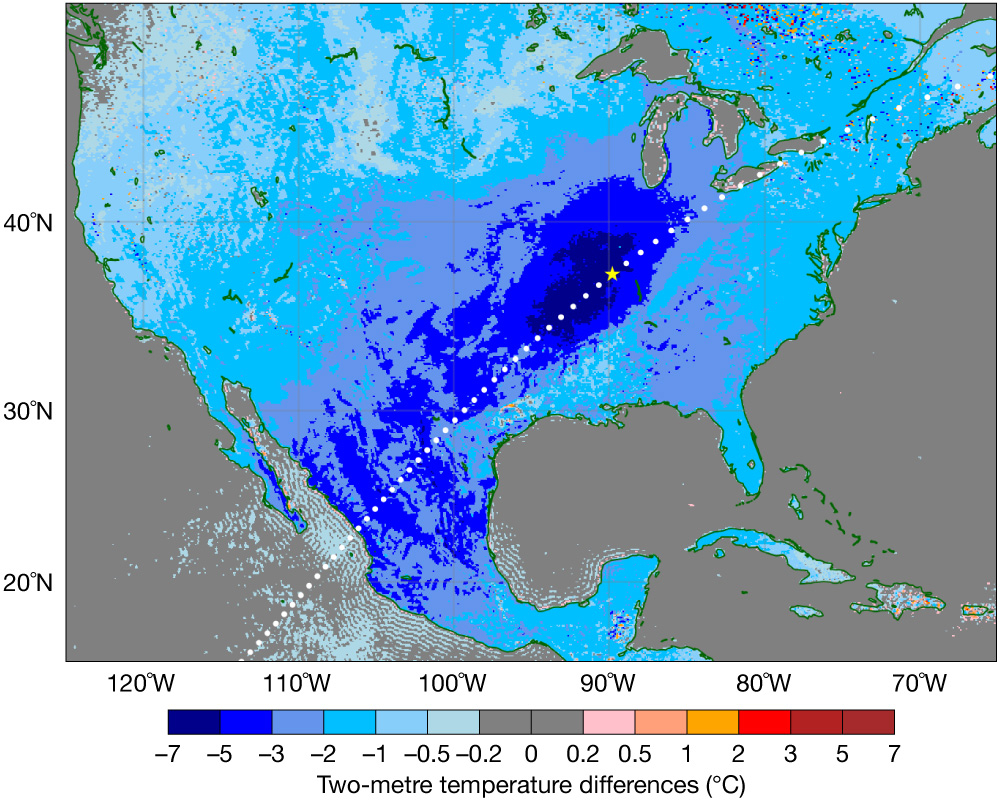Every year, two to five solar eclipses (either total, annular or partial) affect our planet for up to six hours at a time. As documented in the literature using both observations and numerical simulations, the impact of an eclipse day on meteorological conditions can be significant, even in regions where the sun is only partially eclipsed by the moon. Indeed, during an eclipse solar radiation can locally be partially obstructed for up to three hours. The moving region within which obstruction occurs is up to 6,500 km wide. The strongest meteorological effects are found over land within the planetary boundary layer, especially close to the surface, with a local cooling of up to 7°C and a local reduction in wind speed. These low-level meteorological impacts are strongest in fair-weather conditions and for high solar elevations, and they can persist for several hours after the eclipse. Furthermore, temperatures in the stratospheric ozone layer between 15 and 50 km altitude can also drop by several degrees Celsius, through a reduction in the ozone heating rate and, to a lesser extent, changes in chemical processes involving ozone. All these effects will be included in the analysis and in forecasts of ECMWF’s Integrated Forecasting System (IFS) from Cycle 49r2. They will be made operational next year with the upgrade to Cycle 50r1. They will also be included in the next global reanalysis, ERA6.
Computation of solar eclipses
Until now, solar eclipses have been neglected in the IFS. This could occasionally lead to unwelcome large-scale errors, especially in low-level atmospheric temperatures, lasting for several hours. As a result, both analyses and forecasts were degraded, not only in ECMWF’s daily operations but also in reanalyses of past weather, such as ERA5. Although the effects of solar eclipses are not visible in the long-term statistical evaluation of the IFS due to their relative rarity, it is important to capture their effects to improve the forecasts when they do occur. The IFS has therefore been modified to account for the effects of solar eclipses using accurate astronomical computations of the sun’s position (VSOP87D solutions from Bretagnon and Francou, 1988) and of the moon’s position (ELP-MPP02 solutions from Chapront and Francou, 2003). Over the period 1900–2100, the accuracy of the eclipse’s central location on Earth as predicted by the IFS is typically within a couple of kilometres, compared to detailed calculations by NASA. Such a level of accuracy seems adequate for ECMWF’s operational 9 km resolution, but also for kilometre-scale simulations used in ECMWF’s contribution to the EU’s Destination Earth initiative. Larger errors may occur for solar elevations lower than a few degrees, because in these cases the lunar shadow is very elongated. However, in these situations the radiative impact of the eclipse is usually negligible. The fraction of the sun eclipsed by the moon is computed at each location on Earth and used to reduce the incoming solar radiation at the top of the atmosphere, at each model time step.
Impacts on weather forecasts
The dramatic meteorological impact of a total solar eclipse in the IFS is illustrated with an event over North America on 8 April 2024. The figure shows a map of 2‑metre temperature differences between two 9 km IFS 19 h forecasts with and without the solar eclipse included. This was a total solar eclipse that crossed North America from the Pacific coast of Mexico towards Labrador. The figure highlights a drop of up to 6°C in predicted 2‑metre temperature near the eclipse’s maximum over land. A cooling of comparable magnitude was observed using ground station 3‑second measurements kindly provided by the Purdue University Mesonet (Indiana, USA). It is worth emphasising that the sizeable effects of the eclipse are not confined to the 180‑km wide band of totality. They also affect the much wider penumbral region, with a cooling exceeding 1°C over most of the USA and Mexico. The asymmetry in the cooling over the central USA is due to the presence of clouds east of the eclipse path. Another particularly strong impact in the studied case is the reduction in predicted low‑level wind speeds by up to 3 m/s, in agreement with observations. Over sea and large lakes, the impact of the eclipse is negligible, mainly because of the slow thermal response of water to changes in radiation.

Inclusion in data assimilation
The handling of solar eclipses in the IFS has also been added to 4D‑Var data assimilation (DA), since their absence could lead to undesirable, excessive observation–background departures, especially for temperature. The inclusion of eclipses in both 4D‑Var trajectories and minimisations improves the assimilation process, not only because the fit between model and observations gets closer, but also because fewer observations are rejected through quality control in regions affected by the eclipse. Further benefits should be expected when solar reflectance satellite observations start to be assimilated, due to their direct strong dependence on incoming solar radiation.
